Spain has an excellent, fast motorway network and, unlike many European countries, a lot of the stretches are toll free. As a general rule, you’ll only find toll roads on the arterial motorways out of Madrid along the Mediterranean coast, the southern Pyrenees route from Bilbao to Barcelona and around the cities of Seville, Malaga, Leon, Pamplona and Santiago. Toll roads are called ‘carretera de peaje’ or ‘carretera de cuota’and sometimes autopista but the most common indication that you have to pay a toll is simply the word ‘peaje’. On maps and road signs, all toll roads have to include a letter P after the road type so whilst A-33 is free, AP-34 would be a toll road.
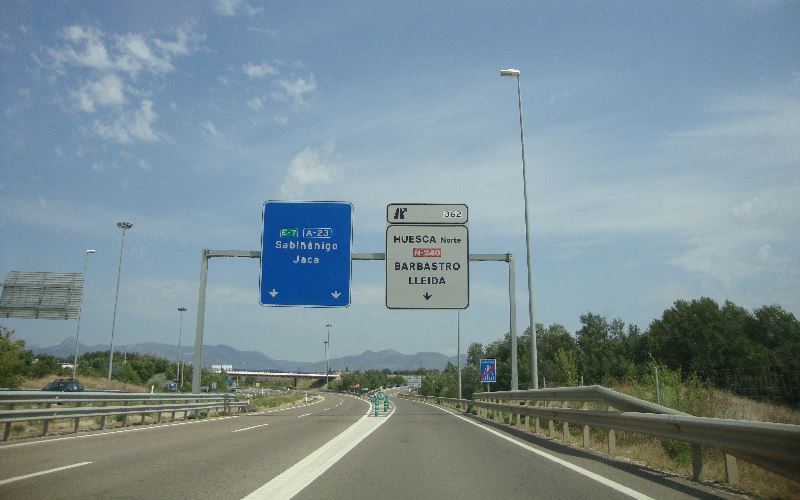
The Spanish authorities have planned their toll roads so that it’s possible to get around the immediate environs of cities without having to pay a charge yet still avoid congestion whilst longer journeys, between cities and regions incur charges. Part of the concessions for toll roads included the need for a free route to parallel the peaje roads meaning that it’s quite simple to avoid toll roads travelling through Spain.
History of Toll Roads in Spain
Spain is relatively new to the idea of motorways and even newer to the idea of toll charges. Whilst fast, multilane carriageways were in existence in the late fifties they weren’t categorised until eighties with the forming of autonomous communities across Spain. At that point, the government, with the local authorities, planned out a network of motorways across Spain some completely new whilst others were formed from the upgrade of existing carriageways. At this point the roads were categorised as autopista – very similar to UK motorways and with similar rules and regulations and autovia, mainly upgraded roads which allow slower traffic and are uniformly toll free. To retain a free alternative to the toll roads, authorities had to ensure an adequate free road followed the ‘peaje’ closely meaning that it is easy to avoid paying tolls in Spain. Some of the free roads are almost as good as the toll roads meaning that in many cases there’s little loss of convenience and time.
Using the Toll Roads
As is common with most toll roads, there are different ways of paying for the journey. The most common is to take a ticket upon entry to the section and, if you want to pay cash, simply present it at a booth when you leave the motorway, paying the required charge. If you wish to pay by credit card, there are specific lanes where you will insert the ticket into a machine, followed by your credit card to make the payment. Some toll roads have a fixed charge no matter what distance you travel along it. There, you simply pay the fixed charge upon leaving the road, either in cash to a booth attendant or by credit card.
A quicker and simpler way is to use the VIA-T box. Whilst this is mainly used by residents who use the toll roads frequently, short term rental of the VIA-T box can be arranged for tourists. The benefit is that once you’ve registered a payment method with the VIA-T box, you’ll be able to simply drive through the VIA-T lane without stopping to pay. It costs €4.50 plus 25c per day to rent.
Cost - How Much Do Toll Roads in Spain Cost?
Spanish toll roads are dotted around the country and many are controlled, or part controlled, by the local authorities who can set toll charges in consultation with the national government. Toll charges vary depending on the length of the road. Some cost as little as a euro per tem kilometres whilst others can be twice that price. The AP-9 from Ferrol to Vigo works out at around a euro for nine kilometres whilst the AP-7 from La Jonquera to Valencia is around a euro for eleven kilometres.
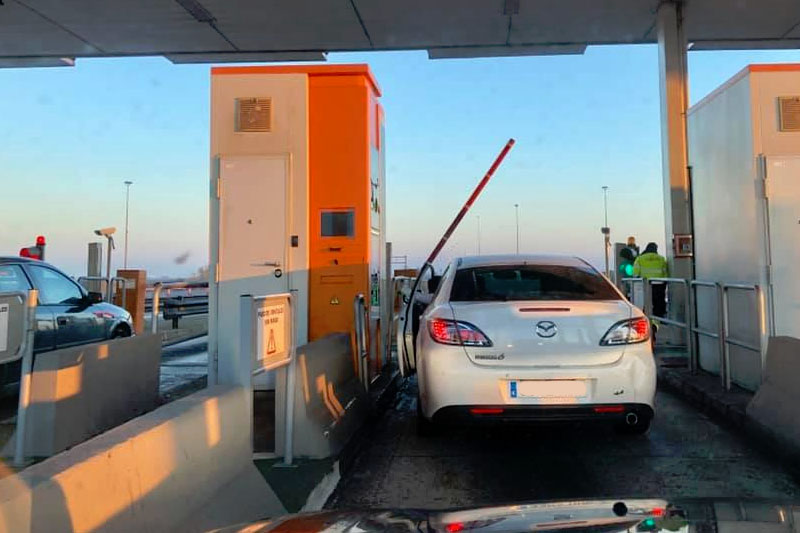
There are advantages and disadvantages with each:
Using Toll Roads
Advantages:
Disadvantages:
- You’ll get there quicker because traffic is lighter and the autopistas are usually less busy and have a higher speed limit- 75 mph in general with a call being made to increase this to 85 mph in places.
- Maintaining an average speed saves on fuel consumption
- The roads are better maintained although new, purpose-built autovias are excellent
- The cost of around a euro per 8 kilometres
- The routes avoid towns and cities so mostly you’ll just see concrete or tarmac and countryside for hundreds of miles
- Fuel prices are much higher on the toll roads and service stations sell typically bland food and drink if you stop there for a break
Using Other Routes
Advantages:
Disadvantages:
- No charges for travelling on them
- Many will pass through villages, towns and cities meaning you can stop off and see some of Spain’s sights, others parallel the toll roads so are only slightly slower
- Fuel is cheaper in the towns and villages and you’ll find beautiful cafes and restaurants for a taste of regional Spanish cuisine
- Driving will be much more interesting with less chance of becoming drowsy from the monotony of the route
- The journey time can be longer as the free roads are typically 10% longer in time and sometimes distance for journeys between A and B
- Fuel costs will be higher because of the extra distance and irregular travelling speeds
- Roads are often less well maintained and there’s a greater chance of getting lost; even with a sat-nav
Sample routes and their costs:
- The AP-7 from Ferrol to Vigo: 180 kms; €19.50 / Journey time approximately 1 hour 45 minutes
- The AP-9 from La Jonquera to Vera: 696 kms; €79.40 / Journey time approximately six and a half hours
- On the AP-68 from Bilbao to Zaragoza: 302 kms; €29.00 / Journey time approximately two and three quarter hours
You can avoid the toll charges if you plan carefully. Many of the national routes are free and of a similar standard to the toll roads. For example, the journey from Bilbao to Zaragoza can be undertaken partly on the NA-129 saving €21 but adding 34kms and half an hour to your journey albeit on a much prettier route.
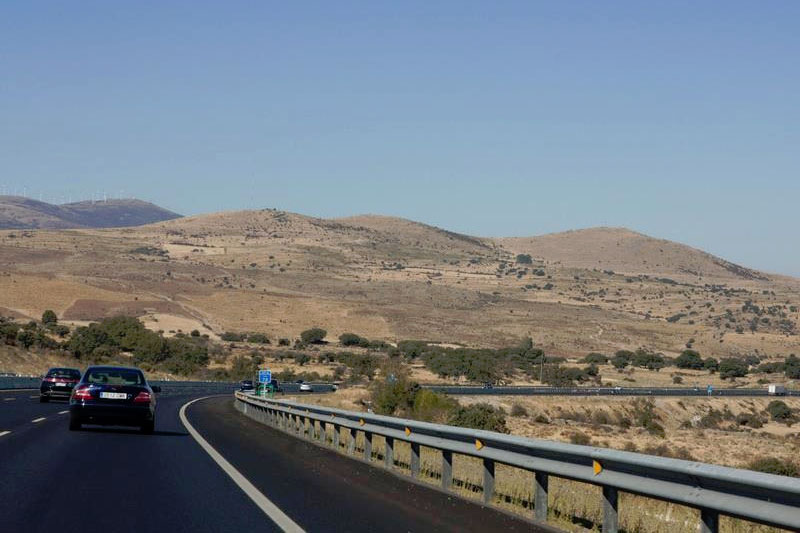
Route planners will give you the toll free next quickest route but if distance saving is more important than time, you can plan direct routes on secondary roads which will save fuel.
Selected Routes - Popular Toll Road Journeys in Spain
Barcelona to Valencia by Toll Road
Toll Charges
€40.85 on the AP-7
Barcelona is a favourite European city break destination for many British travellers. It is full of culture and a showcase of Gaudi’s art and architecture. Flying in from the UK is cheap and easy with budget operators offering year round deals. Many travellers to Barcelona take the opportunity to explore and one of the easiest routes is to take the AP-7 south to
Valencia, home of oranges and the delicious seafood dish, paella.
Leaving Barcelona on the AP-7 you’ll hug the coast, passing
Tarragona before skirting the popular beachside resorts of
Reus and
Salou. Continuing down the Costa Blanca you’ll also have the beauty of several mountainous natural parks to your right as you pass through lesser known but more traditional resorts like Benicarlo and Torreblanca. Finally, after passing through Castellon de la Plana, you’ll arrive in stunning
Valencia. Whilst the AP-7 is a toll road, Spain’s insistence on providing a parallel free road will allow you to take the excellent E-15 route for nothing.
San Sebastian to Bilbao by Toll Road
San Sebastian is one of the most beautiful cities in Spain and completely different to those on the Mediterranean coast. With a beautiful city beach, all you need is more reliable sunshine and it’s the perfect destination for those who want to combine the attractions of a city break and the beach. Bilbao is a stunning city, exampled by the ultra-modern Guggenheim Museum but there’s plenty of art, culture and sport to be enjoyed in the city.
The trip from San Sebastian to Bilbao isn’t long but before the advent of the autopista, it was tortuous, rising and falling through the rugged countryside and coastline. The autopista smooths the journey but still leaves some of the beauty to be enjoyed, albeit at a much faster pace.
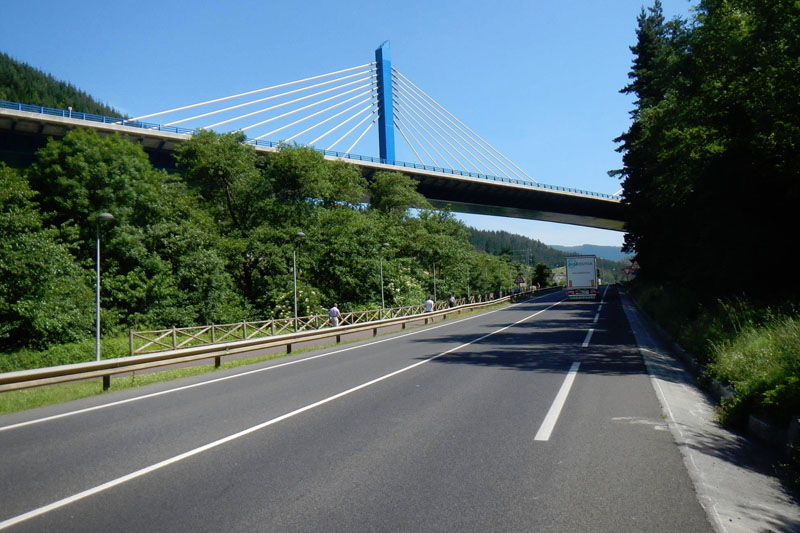
Taking the A-8, unusual in that it’s not an autopista yet it’s still tolled. The attraction is not the villages along the way but the views you’ll enjoy. The journey is only an hour on the A-8 but if you decide to avoid the toll, your journey time can double on the twisting mountain roads that shadow the A-8 along its route. In poor weather, we’d recommend the A-8 over the secondary roads as they can be tricky and dangerous.
Malaga to Algeciras by Toll Road
This is probably the most famous drive in Spain and passes along the AP-7, known as the Autopista del Sol as, for much of its length it parallels the Costa del Sol. In recent years the cities and resorts along this stretch have been refurbished and upgraded so, what was once a synonym for cheap and tatty is now upmarket and attracts celebrity travellers.
This stretch begins in Malaga, the largest city on the Costa, and one which mixes the pleasures of a beach holiday with the stunning architecture of its historic past. A must see is the Alcazaba, the huge fortress that dominates the skyline and below it the remains of Roman Malaga. The trip along the AP-7 is like a roll call of all the famous holiday resorts; Torremolinos, Benaldmena, Fuengirola and Marbella.
The AP-7 is renowned as a dangerous road so care is needed. It’s not because of any fault or difficulty with the road but simply that many drivers exceed the speed limit and drive recklessly. To avoid the autopista completely and enjoy a more leisurely trip along the Costa del Sol, use the N-340 and A-7 which will increase your journey time by another thirty minutes but allows you time to enjoy the view.
Madrid to Segovia by Toll Road
Madrid is the second most popular city break destination in Spain after Barcelona and has much to see including the Prado art museum, one of the finest in the world. The landscape around the city is hot, dry and unforgiving but has some fantastic things to see. Segovia is a Roman city which was added to by the Moors and boasts many amazing architectural highlights including the Alcazar and the aqueduct.
The city is an hour and a quarter outside Madrid at the end of the A-6 and AP-61. The countryside you’ll pass through has several small settlements, none of note so the quick route is certainly the best way to get to Segovia. On the way you’ll still get to see the low mountains of the National Park of Cuelta Alta.
Madrid to Toledo by Toll Road
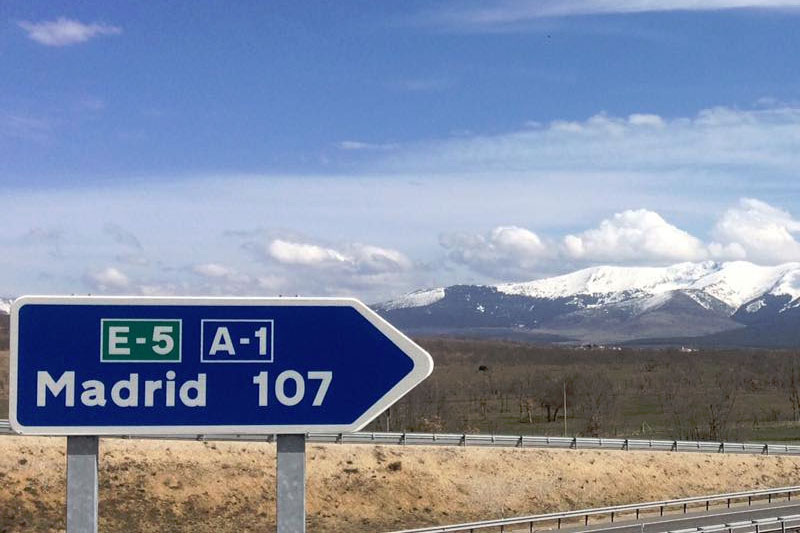
The city of Toledo is a UNESCO World Heritage Site and dates back to early Roman times. It was once the capital of Spain and has preserved its ancient charm in the narrow cobbled streets of the old town. Once overlooked, it has grown in popularity to become one of Spain’s most visited cities.
Getting to Toledo from Madrid is quick and easy along the AP41 which you’ll join from the R-5 out of Madrid’s city centre. The countryside en route is barren and dry with few, if any places of note to make it worth avoiding the toll road.
Map of Toll Roads in Spain
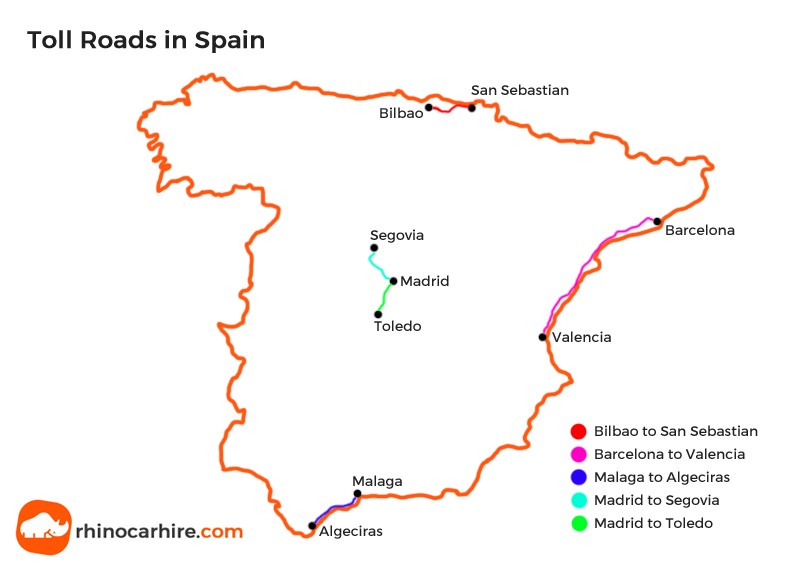 Further Reading on Driving in Spain;
Further Reading on Driving in Spain;